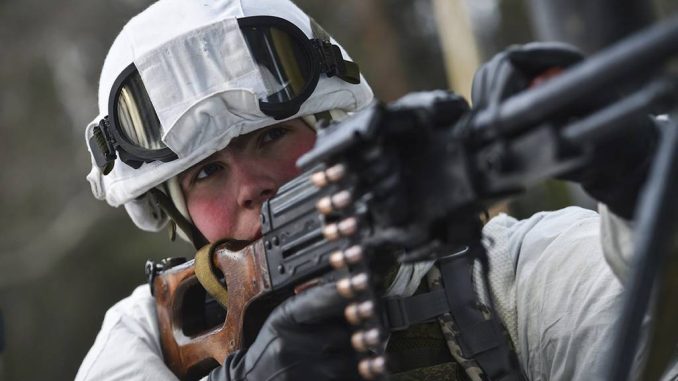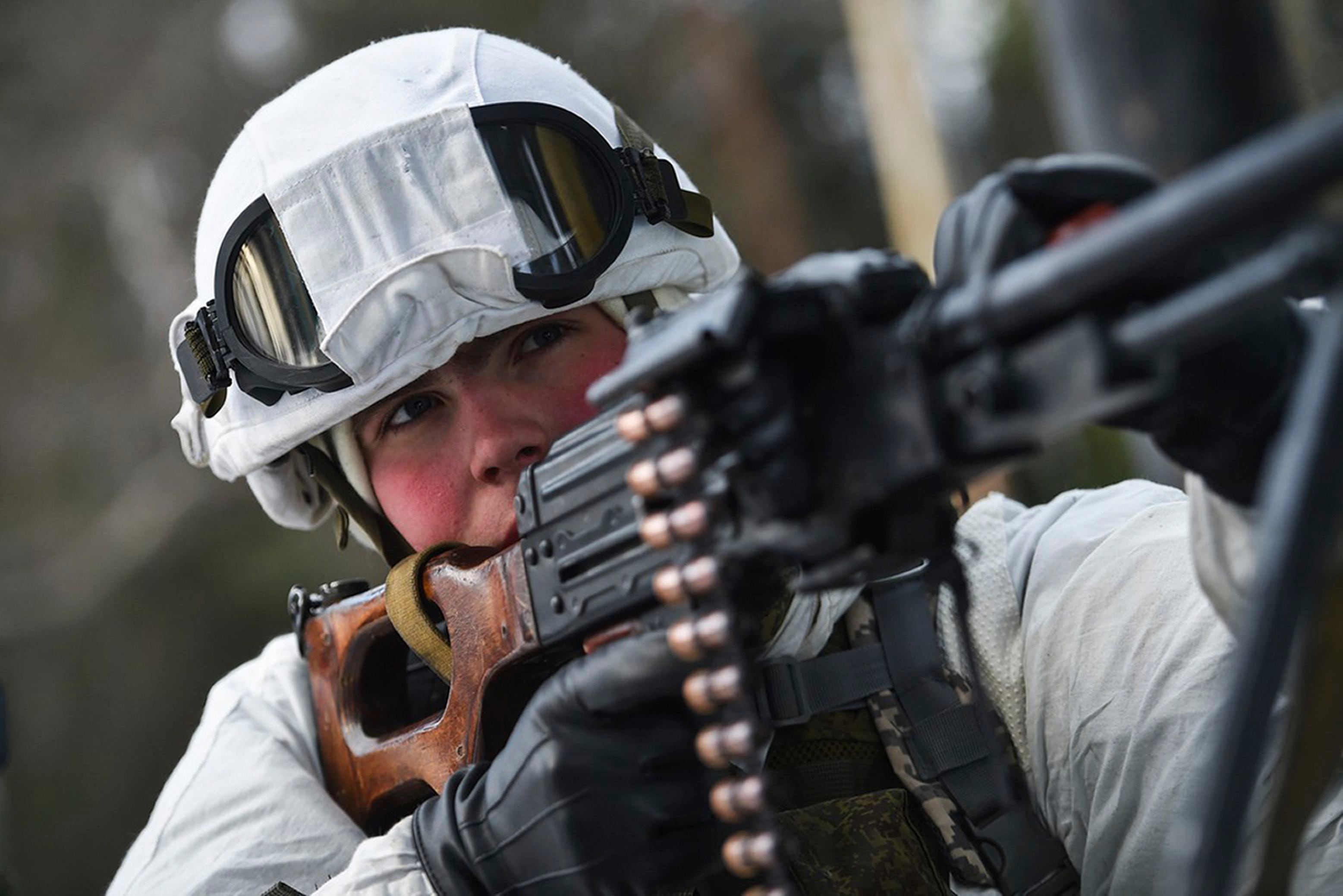

Russian President Vladimir Putin has decided to launch an attack on Ukraine, President Joe Biden said Friday afternoon.
“As of this moment I’m convinced he’s made the decision,” Biden said during a televised address. “We have reason to believe it.”
When pushed on what evidence he has, Biden said “really significant intelligence capability.”
Biden said that “over the last few days, we’ve seen reports of a major uptick in violations of the ceasefire. by Russian-backed fighters attempting to provoke Ukraine in Donbas.. a selling of Ukrainian kindergarten yesterday, which Russia has falsely asserted was carried out by Ukraine. We also continue to see more and more disinformation be pushed out by to the Russian public, including Russian backed separatists, claiming that Ukraine is planning to launch a massive offensive attack.”
His statements came amid aggravated Western fears of a Russian invasion and a new war in Europe, with a humanitarian convoy hit by shelling and pro-Russian rebels evacuating civilians from the conflict zone. A car bombing hit the eastern city of Donetsk, but no casualties were reported.
The Kremlin declared massive nuclear drills to flex its military muscle, and Putin pledged to protect Russia’s national interests against what it sees as encroaching Western threats. U.S. and European leaders, meanwhile, grasped for ways to keep the peace and Europe’s post-Cold War security order.
While Putin held out the possibility of diplomacy, a cascade of developments this week have have further exacerbated East-West tensions and fueled war worries. This week’s actions have fed those concerns: U.S. and European officials, focused on an estimated 150,000 Russian troops posted around Ukraine’s borders, warn the long-simmering separatist conflict in eastern Ukraine could provide the spark for a broader attack.
Vice President Kamala Harris said the U.S. still hopes Russia will de-escalate but is ready to hit it with tough sanctions in case of an attack. U.S. leaders this week issued their most dire warnings yet that Moscow could order an invasion of Ukraine any day.
“We remain, of course, open to and desirous of diplomacy … but we are also committed, if Russia takes aggressive action, to ensure there will be severe consequence,” Harris said at the annual Munich Security Conference.
While Russia snubbed this year’s conference, lines of communication remain open: The U.S. and Russian defense chiefs spoke Friday, and U.S. Defense Secretary Lloyd Austin called for de-escalation, the return of Russian forces surrounding Ukraine to their home bases, and a diplomatic resolution, according to the Pentagon. Secretary of State Antony Blinken and Russian Foreign Minister Sergey Lavrov agreed to meet next week.
Immediate worries focused on eastern Ukraine, where Ukrainian forces have been fighting pro-Russia rebels since 2014 in a conflict that has killed some 14,000 people.
A bombing struck a car outside the main government building in the major eastern city of Donetsk, according to an Associated Press journalist there. The head of the separatists’ forces, Denis Sinenkov, said the car was his, the Interfax news agency reported.
There were no reports of casualties and no independent confirmation of the circumstances of the blast. Uniformed men inspected the burned-out car. Broken glass littered the area,
Shelling and shooting are common along the line that separates Ukrainian forces and the rebels, but targeted violence is unusual in rebel-held cities like Donetsk.
However, the explosion and the announced evacuations were in line with U.S. warnings of so-called false-flag attacks that Russia would use to justify an invasion.
Separatists in the Luhansk and Donetsk regions that form Ukraine’s industrial heartland known as the Donbas said they are evacuating civilians to Russia. The announcement appeared to be part of Moscow’s efforts to counter Western warnings of a Russian invasion and to paint Ukraine as the aggressor instead.
Denis Pushilin, head of the Donetsk rebel government, said women, children and the elderly would go first, and that Russia has prepared facilities for them. Pushilin alleged in a video statement that Ukrainian President Volodymyr Zelenskyy was going to order an imminent offensive in the area.
Metadata from two videos posted by the separatists announcing the evacuation show that the files were created two days ago, The Associated Press confirmed. U.S. authorities have alleged that Kremlin plans included prerecorded videos as part of a disinformation campaign.
Authorities began moving children from an orphanage in Donetsk, and other residents boarded buses for Russia. Long lines formed at gas stations as more people prepared to leave on their own.
Putin ordered his emergencies minister to fly to the Rostov region bordering Ukraine to help organize the exodus and ordered the government to offer a payment of 10,000 rubles (about $130) to each evacuee, equivalent to about half of an average monthly salary in the war-ravaged Donbas.
Ukraine denied planning any offensive, with Foreign Minister Dmytro Kuleba saying that “Ukraine does not conduct or plan any such actions in the Donbas.”
“We are fully committed to diplomatic conflict resolution only,” he tweeted.
Around the volatile line of contact, a UNCHR convoy came under rebel shelling in the Luhansk region, Ukraine’s military chief said. No casualties were reported. Rebels denied involvement and accused Ukraine of staging a provocation.
Separatist authorities reported more shelling by Ukrainian forces along the line. Kremlin spokesman Dmitry Peskov said the situation is “potentially very dangerous.” A surge of shelling Thursday tore through the walls of a kindergarten, injuring two, and basic communications were disrupted. Both sides accused each other of opening fire.
U.S. and European officials have been on high alert for any Russian attempts at a so-called false-flag operation. A Western official familiar with intelligence findings said Ukrainian government officials shared intelligence that suggested the Russians might try to shell the areas in the Luhansk region controlled by separatists, as part of an effort to create a false reason to take military action. The official was not authorized to comment publicly.
U.N. Secretary-General Antonio Guterres said the threat to global security is “more complex and probably higher” than during the Cold War. He told the Munich conference that a small mistake or miscommunication between major powers could have catastrophic consequences.
While Russia announced this week it is pulling back forces from vast military exercises that had sparked fears of an invasion, U.S. officials have said they see no sign of a pullback — and instead saw more troops moving toward the border with Ukraine.
The White House and the U.K. formally accused Russia of being responsible for recent cyberattacks targeting Ukraine’s defense ministry and major banks. The announcement was the most pointed attribution of responsibility for the cyber intrusions.
Also Friday, the U.S. government released new estimates of how many military personnel Russia has in and around Ukraine. It said there are between 169,000 and 190,000 personnel, up from about about 100,000 on Jan. 30, according to Michael Carpenter, the permanent U.S. representative to the Organization for Security and Cooperation in Europe.
The new estimate includes military troops along the border, in Belarus, and in occupied Crimea; Russian National Guard and other internal security units deployed to these areas; and Russian-backed forces in eastern Ukraine. The separatists inside Ukraine, the Russian National Guard and troops in Crimea were not included in the previous U.S. estimate of 150,000.
The Kremlin sent a reminder to the world of its nuclear might, announcing drills of its nuclear forces for the weekend. Putin will monitor the sweeping exercise Saturday that will involve multiple practice missile launches.
The move overshadowed Russian offers of continued diplomacy to defuse the Ukraine crisis.
While the Kremlin insists it has no plans to invade, it has urged the West to keep Ukraine out of NATO and roll back alliance forces from Eastern Europe — demands roundly rejected by Western allies.
Asked about Western warnings of a possible Russian invasion on Wednesday that didn’t materialize, Putin said, “There are so many false claims, and constantly reacting to them is more trouble than it’s worth.”
“We are doing what we consider necessary and will keep doing so,” he said. “We have clear and precise goals conforming to national interests.”
Putin reaffirmed that Russia was open for dialogue on confidence-building measures with the West on condition that they will be discussed in conjunction with Moscow’s main security demands.
NATO allies are also flexing their might, bolstering military forces around Eastern Europe, but insist the actions are purely defensive and to show unity in the face of Russian threats.
The U.S. announced the $6 billion sale of 250 tanks to Poland, a NATO member that has been occupied or attacked by Russia in the past.
Biden spoke by phone Friday with trans-Atlantic leaders about the crisis and continued efforts at deterrence and diplomacy, and to give a speech about the situation.
___
Isachenkov reported from Moscow and Madhani from Munich. Jim Heintz in Moscow, Matthew Lee and Karl Ritter in Munich, Inna Varenytsia in Sieverodonetsk, Ukraine, Mstyslav Chernov in Bakhmut, Ukraine, Jill Lawless in London, Raf Casert in Brussels, Frank Jordans in Berlin, Ellen Knickmeyer and Lolita Baldor in Washington, Vanessa Gera in Warsaw and Angela Charlton in Paris contributed.
Howard Altman is an award-winning editor and reporter who was previously the military reporter for the Tampa Bay Times and before that the Tampa Tribune, where he covered USCENTCOM, USSOCOM and SOF writ large among many other topics.



Be the first to comment